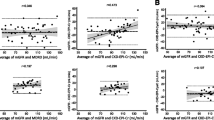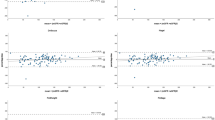Abstract
Purpose
To evaluate equations for estimation of glomerular filtration rate (GFR) and measured urinary creatinine clearance, compared to measured GFR in critically ill patients.
Methods
GFR was measured using inulin clearance. Multiple blood samples were collected per patient for determination of serum creatinine, cystatin C and inulin. GFR was estimated by the use of the following estimation equations (eGFR): four commonly used creatinine-based equations [Cockcroft–Gault, Modification of Diet in Renal Disease (both the short and long formula) and Chronic Kidney Disease Epidemiology Collaboration (CKD-EPI)], five cystatin C based estimation equations (Hoek, Larsson, Filler, Le Bricon, CKD-EPIcys) and one equation combining cystatin C and serum creatinine (CKD-EPIcr-cys). In addition we measured urinary creatinine clearance. Bias, precision and accuracy of all estimates were compared to those of the inulin clearance.
Results
Data were collected from 83 patients, of whom 68 were considered evaluable. The median age was 58 years [interquartile range (IQR) 39–68]. The median inulin clearance was 80 mL/min/1.73 m2 (IQR 31–114). Equations based on creatinine had much bias and poor precision and accuracy. Measured urinary creatinine clearances overestimated GFR. Equations based on cystatin C were free of bias, but also had limited precision and accuracy.
Conclusions
In this cohort of patients, estimates of GFR had low accuracy and precision. Cystatin C based formulas, especially CKD-EPIcr-cys, showed limited bias; however, the accuracy and precision of these estimates were still insufficient. Measured urinary creatinine clearance overestimates GFR, but may provide a cheap alternative, when this is taken into account.




Similar content being viewed by others
References
Roberts JA, Lipman J (2009) Pharmacokinetic issues for antibiotics in the critically ill patient. Crit Care Med 37:840–851
Stevens LA, Coresh J, Greene T, Levey AS (2006) Assessing kidney function—measured and estimated glomerular filtration rate. N Engl J Med 354:2473–2483
Lameire N, Hoste E (2004) Reflections on the definition, classification, and diagnostic evaluation of acute renal failure. Curr Opin Crit Care 10:468–475
Herrera-Gutierrez M, Seller-Perez G, Banderas-Bravo E, Munoz-Bono J, Lebron-Gallardo M, Fernandez-Ortega J (2007) Replacement of 24-h creatinine clearance by 2-h creatinine clearance in intensive care unit patients: a single-center study. Intensive Care Med 33:1900–1906
Stevens LA, Schmid CH, Greene T, Li L, Beck GJ, Joffe MM, Froissart M, Kusek JW, Zhang YL, Coresh J, Levey AS (2009) Factors other than glomerular filtration rate affect serum cystatin C levels. Kidney Int 75:652–660
Knight EL, Verhave JC, Spiegelman D (2004) Factors influencing serum cystatin C levels other than renal function and the impact on renal function measurement. Kidney Int 65:1416–1421
Royakkers AA, Korevaar JC, van Suijlen JD, Hofstra LS, Kuiper MA, Spronk PE, Schultz MJ, Bouman CS (2011) Serum and urine cystatin C are poor biomarkers for acute kidney injury and renal replacement therapy. Intensive Care Med 37:493–501
Hasslacher J, Lehner GF, Joannidis M (2012) Insufficient performance of serum cystatin C as a biomarker for acute kidney injury of postrenal etiology. Intensive Care Med 38:170–171
Bragadottir G, Redfors B, Ricksten SE (2013) Assessing glomerular filtration rate (GFR) in critically ill patients with acute kidney injury—true GFR versus urinary creatinine clearance and estimating equations. Crit Care 17:R108
Erley CM, Bader BD, Berger ED, Vochazer A, Jorzik JJ, Dietz K, Risler T (2001) Plasma clearance of iodine contrast media as a measure of glomerular filtration rate in critically ill patients. Crit Care Med 29:1544–1550
Wharton WW, Sondeen JL, McBiles M, Gradwohl SE, Wade CE, Ciceri DP, Lehmann HG, Stotler RE, Henderson TR, Whitaker WR et al (1992) Measurement of glomerular filtration rate in ICU patients using 99mTc-DTPA and inulin. Kidney Int 42:174–178
Delanaye P, Cavalier E, Morel J, Mehdi M, Maillard N, Claisse G, Lambermont B, Dubois B, Damas P, Krzesinski J-M, Lautrette A, Mariat C (2014) Detection of decreased glomerular filtration rate in intensive care units: serum cystatin C versus serum creatinine. BMC Nephrol 15:9
Baptista J, Udy A, Sousa E, Pimentel J, Wang L, Roberts J, Lipman J (2011) A comparison of estimates of glomerular filtration in critically ill patients with augmented renal clearance. Crit Care 15:R139
Udy AA, Morton FJ, Nguyen-Pham S, Jarrett P, Lassig-Smith M, Stuart J, Dunlop R, Starr T, Boots RJ, Lipman J (2013) A comparison of CKD-EPI estimated glomerular filtration rate and measured creatinine clearance in recently admitted critically ill patients with normal plasma creatinine concentrations. BMC Nephrol 14:250
Kirwan CJ, Philips BJ, Macphee IA (2013) Estimated glomerular filtration rate correlates poorly with four-hour creatinine clearance in critically ill patients with acute kidney injury. Crit Care Res Pract 2013:406075
Hoste EA, Damen J, Vanholder RC, Lameire NH, Delanghe JR, Van den Kristof H, Colardyn FA (2005) Assessment of renal function in recently admitted critically ill patients with normal serum creatinine. Nephrol Dial Transplant 20:747–753
Conil JM, Georges B, Fourcade O, Seguin T, Lavit M, Samii K, Houin G, Tack I, Saivin S (2007) Assessment of renal function in clinical practice at the bedside of burn patients. Br J Clin Pharmacol 63:583–594
Minville V, Asehnoune K, Ruiz S, Breden A, Georges B, Seguin T, Tack I, Jaafar A, Saivin S, Fourcade O, Samii K, Conil JM (2011) Increased creatinine clearance in polytrauma patients with normal serum creatinine: a retrospective observational study. Crit Care 15:R49
Van Eynde R, Vanthuyne S, Lameire N, Delanghe J, Decruyenaere J, Hoste E (2005) Assessment of renal function in critically ill patients. Intensive Care Med 31(Suppl 1):S85 abstract
Picavet S, Vanthuyne S, Van Eynde R, Lameire N, Delanghe J, Hoste E (2006) Assessment of kidney function in ICU patients. Crit Care 10(Suppl 1):P276 abstract
Janssen A, Dumoulin A, De Waele J, Vanholder R, Waterloos M, Hoste E (2010) Assessment of increased glomerular filtration rate in ICU patients. Intensive Care Med 36(Suppl 2):S402 abstract
Bjornsson TD (1979) Use of serum creatinine concentrations to determine renal function. Clin Pharmacokinet 4:200–222
Cockcroft D, Gault M (1976) Prediction of creatinine clearance from serum creatinine. Nephron 16:31–41
Levey AS, Coresh J, Greene T (2006) Using standardized serum creatinine values in the modification of diet in renal disease study equation for estimating glomerular filtration rate. Ann Intern Med 145:247–254
Levey AS, Coresh J, Greene T, Marsh J, Stevens LA, Kusek JW, Van Lente F (2007) Expressing the Modification of Diet in Renal Disease Study equation for estimating glomerular filtration rate with standardized serum creatinine values. Clin Chem 53:766–772
Levey AS, Stevens LA, Schmid CH (2009) A new equation to estimate glomerular filtration rate. Ann Intern Med 150:604–612
Filler G, Lepage N (2003) Should the Schwartz formula for estimation of GFR be replaced by cystatin C formula? Pediatr Nephrol 18:981–985
Hoek FJ, Kemperman FA, Krediet RT (2003) A comparison between cystatin C, plasma creatinine and the Cockcroft and Gault formula for the estimation of glomerular filtration rate. Nephrol Dial Transplant 18:2024–2031
Larsson A, Malm J, Grubb A, Hansson LO (2004) Calculation of glomerular filtration rate expressed in mL/min from plasma cystatin C values in mg/L. Scand J Clin Lab Invest 64:25–30
Le Bricon T, Leblanc I, Benlakehal M, Gay-Bellile C, Erlich D, Boudaoud S (2005) Evaluation of renal function in intensive care: plasma cystatin C vs. creatinine and derived glomerular filtration rate estimates. Clin Chem Lab Med 43:953–957
Inker LA, Schmid CH, Tighiouart H, Eckfeldt JH, Feldman HI, Greene T, Kusek JW, Manzi J, Van Lente F, Zhang YL, Coresh J, Levey AS (2012) Estimating glomerular filtration rate from serum creatinine and cystatin C. N Engl J Med 367:20–29
Schetz M, Gunst J, Van den Berghe G (2014) The impact of using estimated GFR versus creatinine clearance on the evaluation of recovery from acute kidney injury in the ICU. Intensive Care Med 40:1709–1717
Macedo E, Bouchard J, Soroko SH, Chertow GM, Himmelfarb J, Ikizler TA, Paganini EP, Mehta RL (2010) Fluid accumulation, recognition and staging of acute kidney injury in critically-ill patients. Crit Care 14:R82
Shannon JA (1935) The renal excretion of creatinine in man. J Clin Invest 14:403–410
Molitoris BA (2013) Measuring glomerular filtration rate in the intensive care unit: no substitutes please. Crit Care 17:181
Wang E, Meier DJ, Sandoval RM, Von Hendy-Willson VE, Pressler BM, Bunch RM, Alloosh M, Sturek MS, Schwartz GJ, Molitoris BA (2012) A portable fiberoptic ratiometric fluorescence analyzer provides rapid point-of-care determination of glomerular filtration rate in large animals. Kidney Int 81:112–117
Carlier M, Carrette S, Roberts J, Stove V, Verstraete A, Hoste E, Decruyenaere J, Depuydt P, Lipman J, Wallis S, De Waele J (2013) Meropenem and piperacillin/tazobactam prescribing in critically ill patients: does augmented renal clearance affect pharmacokinetic/pharmacodynamic target attainment when extended infusions are used? Crit Care 17:R84
Udy AA, Varghese JM, Altukroni M, Briscoe S, McWhinney BC, Ungerer JP, Lipman J, Roberts JA (2012) Subtherapeutic initial beta-lactam concentrations in select critically ill patients: association between augmented renal clearance and low trough drug concentrations. Chest 142:30–39
Panteghini M (2008) Enzymatic assays for creatinine: time for action. Clin Chem Lab Med 46:567–572
Acknowledgments
M. Carlier is funded through a pre-doctoral mandate by the Research Foundation Flanders. E. Hoste and J. De Waele are both senior clinical investigators from the Research Foundation Flanders. We would like to thank Mrs. Waterloos from the Department of Nephrology for measurement of inulin concentrations.
Conflicts of interest
EH has received speakers fees from Astute Medical and contributed to clinical studies on biomarkers from the same company. In addition, he is co-investigator for an academic sponsored study on kidney biomarkers. The other authors declare no conflicts of interest.
Author information
Authors and Affiliations
Corresponding author
Additional information
Take home message: Estimates of glomerular filtration rate (GFR) (including measured urinary creatinine clearance) have low accuracy and precision in critically ill patients. Equations based on creatinine performed worst and should not be used in critically ill patients. Cystatin C based formulas, especially the newest CKD-EPIcr-cys, performed reasonably. When overestimation of GFR is taken into account, urinary creatinine clearance measurement may provide a cheaper alternative with comparable accuracy and precision.
Electronic supplementary material
Below is the link to the electronic supplementary material.
Rights and permissions
About this article
Cite this article
Carlier, M., Dumoulin, A., Janssen, A. et al. Comparison of different equations to assess glomerular filtration in critically ill patients. Intensive Care Med 41, 427–435 (2015). https://doi.org/10.1007/s00134-014-3641-9
Received:
Accepted:
Published:
Issue Date:
DOI: https://doi.org/10.1007/s00134-014-3641-9




